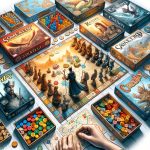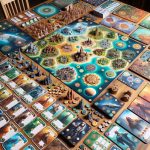Board games have been a staple of entertainment and social interaction for centuries, but their impact goes beyond mere recreation. These timeless classics hold the power to teach strategy in a fun and engaging way.
From ancient times to modern classics, board games have evolved into various types – strategy, luck-based, cooperative, and competitive. This article will delve into how board games teach strategy and critical thinking skills, the history of board games, popular choices for teaching strategy, their benefits, and tips for using them in educational settings.
The history of board games dates back to ancient civilizations and has seen a steady evolution to the modern classics we know today. Whether it’s Settlers of Catan, Chess or Risk – these games not only provide entertainment but also serve as powerful tools for developing critical thinking, decision making, and problem-solving skills. Through this article, we will explore the ways in which these classic titles contribute to cognitive development and stress relief.
In educational settings, incorporating board games can lead to enhanced learning experiences through classroom activities, team building exercises and interactive resources. As technology continues to advance, the future of board games in teaching strategy is set to incorporate virtual reality integration and gamification techniques – offering an exciting prospect for students and educators alike.
The History of Board Games
From Ancient Times to Modern Classics
Throughout history, board games have evolved and adapted to reflect the changing world around them. From the invention of chess in India during the 6th century to the creation of popular modern classics like Monopoly and Clue in the 20th century, board games have remained a staple form of entertainment and education for people of all ages. The enduring popularity of these games is a testament to their ability to teach strategy while providing an enjoyable and engaging experience.
The Role of Board Games in Teaching Strategy
Board games have always been valued for their ability to teach strategic thinking, decision-making, and problem-solving skills. Whether it’s learning how to manage resources in Settlers of Catan or planning military tactics in Risk, players are constantly challenged to think critically and make calculated moves in order to succeed. The interactive nature of board games also fosters collaboration and competition, allowing players to learn from each other while honing their strategic abilities.
From ancient civilization to modern classics, board games have continued to be a valuable tool for teaching strategy while providing entertainment. As technology continues to advance, it will be interesting to see how traditional board games adapt and integrate with virtual reality and gamification to continue teaching valuable skills in new and exciting ways.
Types of Board Games
Board games come in a variety of types, each with its own unique gameplay and challenges. Understanding the different types of board games can help individuals choose the best game for their preferences and skill level.
1. Strategy Board Games: These games rely on a player’s decision-making skills, critical thinking, and long-term planning. Some popular strategy board games include Settlers of Catan, Risk, Chess, and Ticket to Ride. These games often involve resource management and strategic placement of pieces to outmaneuver opponents.
2. Luck-Based Board Games: In contrast to strategy games, luck-based board games rely more heavily on chance rather than strategy. Popular examples of luck-based board games include Monopoly, Candy Land, and Snakes and Ladders. While these games still require some decision-making skills, the outcome is largely determined by luck.
3. Cooperative Board Games: Cooperative board games are designed for players to work together as a team to achieve a common goal. Games like Pandemic and Forbidden Island require players to communicate effectively, strategize as a group, and make decisions that benefit the entire team.
4. Competitive Board Games: Competitive board games pit players against each other in direct competition. These can include classic games like Scrabble or more modern titles like Codenames or Azul. Competitive board games teach valuable skills such as sportsmanship, tactical thinking, and adaptability.
Understanding the different types of board games allows educators and families alike to select the best options for teaching strategy while also catering to individual preferences for gameplay style.
How Board Games Teach Strategy
Board games are not just a fun way to pass the time, but they also offer an excellent opportunity for teaching strategy. Whether it’s through critical thinking, decision making, or problem-solving skills, board games provide a platform for players to develop these essential abilities in an enjoyable and engaging way. Here are some ways board games can teach these important skills:
- Critical Thinking: Board games often require players to analyze the game state, consider various options, and anticipate their opponents’ moves. This process encourages critical thinking as players weigh the potential outcomes of their decisions.
- Decision Making: In many board games, players are faced with choices that have consequences on the game’s outcome. This aspect of decision making is crucial in understanding the impact of one’s actions and learning how to make effective choices.
- Problem Solving Skills: Board games present players with various challenges that require creative problem solving. Whether it’s finding the best route in a game like Ticket to Ride or managing resources in Settlers of Catan, these activities promote cognitive development and strategic thinking.
By engaging in these aspects of gameplay, individuals can enhance their ability to think critically, make informed decisions, and solve problems effectively-skills that are applicable not only in board games but also in real-life situations.
Incorporating board games into educational settings can be a valuable tool for fostering these skills among students. By integrating strategic board games into lesson plans or extracurricular activities, educators can provide an interactive platform for young learners to develop their critical thinking, decision making, and problem-solving abilities while having fun at the same time.
Popular Board Games for Teaching Strategy
Board games have long been used as a tool for teaching strategy, critical thinking, and decision making skills. Some of the most popular board games in this category include Settlers of Catan, Risk, Chess, and more. These games require players to think ahead, anticipate their opponents’ moves, and make calculated decisions in order to win.
Settlers of Catan is a strategy board game that has gained widespread popularity since its release in 1995. The game involves players collecting and trading resources to build settlements and roads on the fictional island of Catan. With its emphasis on resource management and negotiation, Settlers of Catan is a great way to develop strategic thinking skills while also fostering social interaction.
Risk is another classic strategy board game that challenges players to conquer territories and continents through tactical maneuvering and careful planning. The game requires players to assess risks, form alliances, and make strategic decisions in order to dominate the world map.
Chess, one of the oldest board games in existence, is widely recognized as an effective tool for teaching strategic thinking. The game’s focus on spatial reasoning, pattern recognition, and long-term planning makes it an ideal way to develop critical thinking skills in both children and adults.
| Board Game | Description |
|---|---|
| Settlers of Catan | A strategy board game involving resource management and negotiation |
| Risk | A classic game challenging players with conquering territories through tactical maneuvering |
| Chess | An ancient game focusing on spatial reasoning and long-term planning |
The Benefits of Playing Board Games
Playing board games offers a wide range of benefits beyond just entertainment. From improving social skills to reducing stress, the advantages of playing board games are numerous.
Social Skills
One of the key benefits of playing board games is the development of social skills. Board games require players to interact with one another, communicate effectively, and practice good sportsmanship. Whether it’s negotiating trades in Settlers of Catan or strategizing together in cooperative games like Pandemic, players must work together and engage in healthy competition.
Cognitive Development
Board games also offer cognitive benefits, particularly in the realm of critical thinking and decision making. Many board games require players to think several moves ahead, analyze different options, and make strategic decisions based on their opponents’ moves. Games like chess, for example, are known for their ability to enhance problem-solving skills and overall cognitive function.
Stress Relief
In addition to social and cognitive benefits, playing board games can also provide stress relief. Engaging in a fun and lighthearted activity with friends or family can be a great way to unwind and take a break from the pressures of everyday life. The immersive nature of board games can help players relax and focus on something enjoyable, thereby reducing stress levels.
Overall, the benefits of playing board games go far beyond mere entertainment. They offer valuable opportunities for social interaction, cognitive development, and stress relief-an important reminder that sometimes unplugging from technology and engaging in an analog activity can be incredibly beneficial for our well-being.
Tips for Using Board Games in Educational Settings
Board games have been used for centuries as a tool for teaching strategy, critical thinking, and decision-making skills. In educational settings, board games can be a valuable resource for engaging students and promoting learning in an interactive and enjoyable way. Classroom activities, team building exercises, and learning resources centered around board games can provide numerous benefits for students of all ages.
One of the primary advantages of using board games in educational settings is the development of strategic thinking skills. Games such as Settlers of Catan, Risk, and Chess require players to plan ahead, make calculated decisions, and adapt to changing circumstances – all essential components of developing effective strategy. By actively engaging in gameplay, students can hone their analytical abilities and learn to assess options while considering potential outcomes.
In addition to promoting strategic thinking, board games also foster social skills and teamwork. Many educational board games are designed for multiplayer participation, encouraging students to communicate effectively, collaborate with others, and work towards common goals. These activities help students develop important interpersonal skills that are fundamental for success both academically and in various social environments.
Furthermore, integrating board games into classroom activities can offer a welcome break from traditional teaching methods while still reinforcing core concepts. Team building exercises using board games can create a sense of camaraderie among students as they work together towards shared objectives. Additionally, the use of learning resources based on board games can be instrumental in engaging different learning styles and keeping students motivated.
| Advantages | Benefits |
|---|---|
| Promotes strategic thinking | Enhances critical thinking skills |
| Fosters social skills and teamwork | Encourages collaboration |
| Diversifies classroom activities | Keeps students engaged |
The Future of Board Games and Strategy Education
In conclusion, board games are an invaluable tool for teaching strategy, critical thinking, and decision-making skills. From ancient times to modern classics, these games have stood the test of time and continue to be a popular way for people of all ages to engage their minds and have fun at the same time. With the advancement of technology, the future of board games and strategy education looks very promising.
The integration of technology, gamification, and virtual reality into board games has the potential to revolutionize how strategy is taught and learned. These innovations can enhance the overall gaming experience, making it more immersive and interactive. By incorporating technology into traditional board games, educators can engage students in a way that is both entertaining and educational.
As we look ahead, it is important to recognize the continued value of board games in teaching strategy. While technology has its place in enhancing these experiences, the fundamental principles behind board games remain unchanged.
The cognitive development, social skills, and stress relief that board games provide are timeless benefits that will continue to be relevant in an ever-changing world. With careful integration of new technologies, board games can remain a powerful tool for teaching strategy well into the future.
Frequently Asked Questions
What Is the Teaching Strategy That Uses Games?
The teaching strategy that uses games is called gamification. This approach involves incorporating game elements, such as competition, rewards, and challenges, into the learning process to increase engagement and motivation in students.
What Is Board Game Strategy?
Board game strategy refers to the plan or method employed by a player to achieve the objective of winning the game. This could involve making calculated moves, anticipating opponents’ actions, and adapting to changing circumstances during gameplay.
How Do You Make a Board Game Lesson Plan?
Making a board game lesson plan involves identifying the learning objectives, selecting a suitable game that aligns with those objectives, determining how the game will be integrated into the curriculum, planning for assessment of student learning during gameplay, and considering any modifications or adjustments needed for diverse learners.
It’s essential to ensure that the game enhances the students’ understanding of the subject matter being taught while providing an enjoyable experience.

I love playing all kinds of games – from classics like Monopoly to modern favourites like Ticket to Ride.
I created this blog as a way to share my love of board games with others, and provide information on the latest releases and news in the industry.





